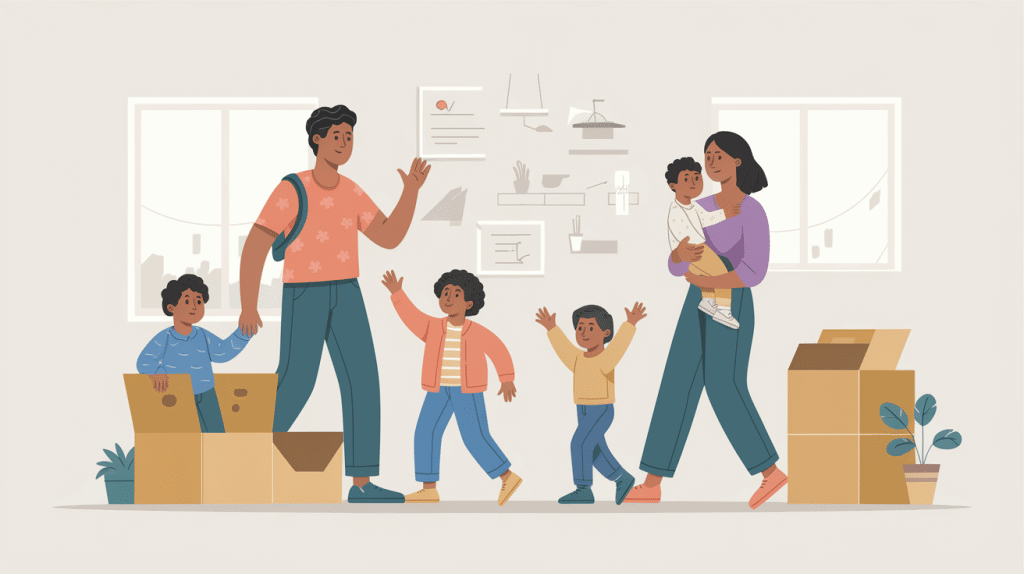Moving to a new home can be a stressful experience for anyone, but the process can feel even more overwhelming when you have kids. The excitement of a new place is often overshadowed by the challenges of packing up your life, organizing everything, and managing your children’s emotions during the transition. Fortunately, with the proper planning and a few key strategies, moving with kids can be a much smoother process. Here are the best moving tips for families, ensuring that the move is as seamless and stress-free as possible for everyone involved.
1. Before the Move: Planning and Preparation
The key to a successful move starts long before the moving truck arrives. Proper planning can make the entire process easier for you and your children.
Involve Your Kids in the Process
It’s essential to involve your children in the moving process, but how you do this depends on their age. Younger children should talk about the move in a positive way. Use simple language to explain that you’re moving to a new house, and highlight the exciting aspects, like a bigger room, a new play area, or a nearby park. You can be more detailed for older children and ask for their input on the move. This helps them feel involved and less anxious about the change.
Give them small tasks to complete. Even toddlers can help by packing their toys into boxes, while older kids can sort through clothes and belongings. This makes them feel helpful and distracts them from any fears or worries about the move.
Create a Moving Timeline
A clear timeline is essential when moving with children. Set specific dates for tasks like packing, contacting utility companies, and hiring movers. The more organized you are, the less chaotic the move will feel. Create a checklist of things to do, and break them into manageable chunks. This will help you prioritize tasks and ensure nothing important slips through the cracks.
Make sure to plan for family activities around the move. Schedule time to relax so your children don’t feel overwhelmed by all the hustle and bustle.
Declutter Together
Moving is the perfect opportunity to declutter your home and eliminate items that no longer serve you. Involve your kids in deciding what to keep, donate, or sell. Children often have emotional attachments to their toys and belongings, so give them the chance to determine which items they truly want to bring with them. You can turn this into a fun activity by creating a donation pile or selling unwanted items for extra cash.
A decluttering session also makes packing easier. By sorting through items in advance, you’ll have fewer things to pack, and you can focus on the most essential items for the move.
2. Packing with Kids: Tips and Tricks
Packing is one of the most time-consuming tasks when moving, but there are ways to make it more manageable, especially when you have kids to consider.
Pack in Stages
Packing up your entire home at once can be overwhelming, so break the task into more miniature stages. Start with non-essential items—things you don’t need in the weeks leading up to the move. Pack up off-season clothes, extra kitchen gadgets, and other items you don’t use daily. Leave the everyday essentials, like clothes and toiletries, for the last few days.
Having a clear plan for when to pack certain items helps keep the stress to a minimum. It also makes things easier on your kids, who won’t feel everything is being uprooted at once.
Use a Color-Coding System
One helpful packing strategy is to color-code your boxes. Assign a specific color for each room in the house. For example, all boxes for the kitchen could be labeled with a green sticker, while the bedrooms could use blue or pink labels. This simple system helps ensure that everything ends up in the right room once you arrive at your new home.
For your kids, label their belongings clearly and make sure their things are packed last, so they have easy access to them during the move.
Make Packing Fun
Packing doesn’t have to be a chore. Turn it into a game by challenging your kids to see how quickly they can pack their toys or clothes into boxes. You can even make it more exciting by creating a packing competition. Give them a specific number of boxes to fill within a particular time, and offer a reward when they complete the task.
By making packing a fun and engaging activity, your kids are less likely to feel stressed or anxious, and you can get the job done more efficiently.
3. Moving Day: Keeping Kids Calm and Safe
It’s essential to keep your kids calm and comfortable on moving day. The chaos of the move can make even the most organized household feel hectic, so keeping things structured is key.
Establish a Moving Day Routine
Moving day should still feel normal for your children, even amid a significant change. Try to stick to their usual routine as much as possible. Keep meals, naps, and bedtime on schedule, if you can. This consistency can help them feel a sense of stability amid the confusion of the move.
Hire a sitter or have a relative look after your kids during the most hectic part of the move. This lets you focus on the logistics while ensuring your children are safe and entertained.
Prepare a “Moving Day Kit”
A “moving day kit” is a must for families. This kit should include snacks, drinks, entertainment, and comfort items your kids can access easily. Pack a bag with their favorite toys, books, or a tablet to keep them occupied while packing last-minute items. Don’t forget comfort items like stuffed animals or blankets, which make your kids feel secure in a new and unfamiliar environment.
Safety First
Safety is a top priority on moving day. With so many boxes and heavy furniture being moved around, it’s easy for kids to get in the way or accidentally hurt themselves. Keep your children in a designated safe space while loading the truck or organizing the house. Have a family member or friend look after them until everything is set up in the new home.
Getting Help from Professionals
Sometimes, managing a move with kids can become overwhelming despite your best efforts. Professional moving services can make a difference. Many moving companies offer family-focused packages that include the physical move and child-friendly services like specialized packing for their belongings or even moving-day childcare options. If you’re considering extra help, request a moving quote to see how affordable these services can be. Hiring professionals can help you streamline the moving process, leaving you with more time and energy to focus on your family’s well-being during this transition.
4. Settling into the New Home
Once the move is complete, your kids will likely feel excitement and anxiety about the new house. The next step is making them feel at home.
Create a Familiar Space for Your Kids
The first room you should unpack is your child’s room. Unpacking their items will help them feel more settled and give them a familiar space to retreat to. Arrange the furniture in a way that feels comfortable for them, and make sure their favorite toys or books are easily accessible. The more you can make their new room feel like their old one, the smoother the transition will be.
Let them help you with the decorating process. This gives them a sense of control and helps them take ownership of their new space.
Explore the New Home Together
Take a family tour of your new home and neighborhood. Show your kids where everything is and encourage them to explore. If any parks or playgrounds are nearby, take them there to explore the new surroundings. The more you can involve them in discovering their new home, the more excited they’ll be about the change.
5. Emotional Support: Helping Kids Adjust
Relocating can be an emotional experience for children. They may have mixed feelings about leaving behind friends or their old home, so offering emotional support is essential.
Acknowledge Their Feelings
Let your kids know that it’s okay to feel sad or nervous about the move. Acknowledge their feelings and allow them to talk about any worries. They need to know that their emotions are valid and that you understand what they’re going through.
Maintain Consistency
Try to keep as much of their routine the same as possible. Whether it’s bedtime, meals, or family activities, maintaining consistency helps provide a sense of security for your kids during this transitional period.
Plan Fun Activities
One way to ease your children’s adjustment is to plan fun activities after the move. Whether it’s visiting a new local attraction or setting up playdates with other kids in the neighborhood, creating positive experiences will help them form new memories in their new home.
6. Moving Steps Overview
To recap, here are the key moving steps when relocating with kids:
- Step 1: Plan ahead and involve your kids in the process.
- Step 2: Declutter and organize early to reduce stress.
- Step 3: Pack smartly and make the experience enjoyable.
- Step 4: Keep kids safe and entertained on moving day.
- Step 5: Unpack and create a homey environment quickly.
- Step 6: Support kids emotionally as they adjust to their new home.
Conclusion
Moving with kids is undeniably challenging, but it can be a positive and even exciting experience with careful planning and a few thoughtful strategies. By preparing ahead of time, packing efficiently, and providing emotional support, you can help your kids feel secure and excited about their new home. With the right approach, the whole family will be settled in and ready to create new memories.




















